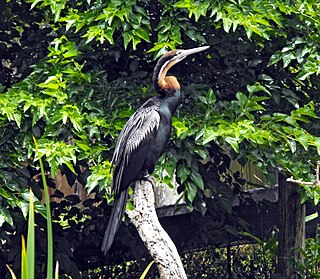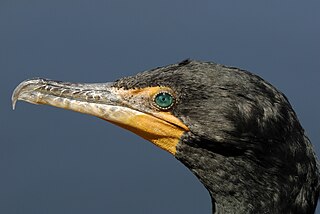Related Research Articles

Becker County is a county in the U.S. state of Minnesota. As of the 2020 census, the population was 35,183. Its county seat is Detroit Lakes. Part of the White Earth Indian Reservation extends into the county. The county was created in 1858 and organized in 1871.
Audubon Township is a township in Becker County, Minnesota, United States. The population was 416 at the 2000 census.
Cormorant Township is a township in Becker County, Minnesota, United States. The population was 1,039 as of the 2010 census.
Lake Eunice Township is a township in Becker County, Minnesota, United States. The population was 1,538 as of the 2010 census.

The darters, anhingas, or snakebirds are mainly tropical waterbirds in the family Anhingidae, which contains a single genus, Anhinga. There are four living species, three of which are very common and widespread while the fourth is rarer and classified as near-threatened by the IUCN. The term snakebird is usually used without any additions to signify whichever of the completely allopatric species occurs in any one region. It refers to their long thin neck, which has a snake-like appearance when they swim with their bodies submerged, or when mated pairs twist it during their bonding displays. "Darter" is used with a geographical term when referring to particular species. It alludes to their manner of procuring food, as they impale fishes with their thin, pointed beak. The American darter is more commonly known as the anhinga. It is sometimes called "water turkey" in the southern United States; though the anhinga is quite unrelated to the wild turkey, they are both large, blackish birds with long tails that are sometimes hunted for food.

The double-crested cormorant is a member of the cormorant family of water birds. It is found near rivers and lakes and in coastal areas and is widely distributed across North America, from the Aleutian Islands in Alaska down to Florida and Mexico. Measuring 70–90 cm (28–35 in) in length, it is entirely black except for a bare patch of orange-yellow facial skin and some extra plumage that it exhibits in the breeding season when it grows a double crest in which black feathers are mingled with white. Five subspecies are recognized. It mainly eats fish and hunts by swimming and diving. Its feathers, like all cormorants, are not waterproof, and it must dry them out after spending time in the water. Once threatened by the use of DDT, the numbers of this bird have increased markedly in recent years.

The yellow perch, commonly referred to as perch, striped perch, American perch or preacher is a freshwater perciform fish native to much of North America. The yellow perch was described in 1814 by Samuel Latham Mitchill from New York. It is closely related, and morphologically similar to the European perch ; and is sometimes considered a subspecies of its European counterpart.
A cormorant is a family of approximately 40 species of sea bird.

Lake Shetek State Park is a state park of Minnesota, United States, on Lake Shetek, which is the largest lake in southwestern Minnesota and the headwaters of the Des Moines River. It is most popular for water recreation and camping. However the park also contains historical resources related to the Dakota War of 1862, including an original log cabin and a monument to 15 white settlers killed there and at nearby Slaughter Slough on August 20, 1862.
Pocono Peak Lake is a lake in Lehigh Township, Wayne County, Pennsylvania in the United States. The lake is the origin of the Lehigh River.

The 1980 United States presidential election in Minnesota took place on November 4, 1980, as part of the 1980 United States presidential election. State voters chose ten representatives, or electors to the Electoral College, who voted for President and Vice-president.

Cormorant culling is the intentional killing of cormorants by humans for the purposes of wildlife management. It has been practiced for centuries, with supporters of culling generally arising from the angling community. Culling techniques may involve the killing of birds, the destruction of eggs, or both. Historically, culls have occurred to protect the interests of recreational and commercial fishermen who perceive the animals to be competing with them for their intended catch or for the prey of their intended catch. Since the 1960s, the growing aquaculture industry has undertaken cormorant culls to protect its farmed fish and crustacean stocks. Opponents of cormorant culling include conservation groups such as the National Audubon Society, Cormorant Defenders International and Sea Shepherd.
Serpent Lake is a lake in Crosby and Deerwood, Crow Wing County, in the U.S. state of Minnesota spanning 1,103 acres. Fish that swim there include: Black Bullhead, Bluegill, Brown Bullhead, Largemouth Bass, Northern Pike, Pumpkinseed, Rock Bass, Smallmouth Bass, Walleye, Yellow Bullhead and Yellow Perch. Serpent Lake is an English translation of the Ojibwe language name.
Big Cormorant Lake is located in northwestern Minnesota's Becker County, about an hour's drive due east of the Fargo, North Dakota and Moorhead, Minnesota metropolitan area. Public access boat ramps are located on the northeast and west sides of the Lake.
Lake Elizabeth is a shallow glacial lake in Kandiyohi County, in the U.S. state of Minnesota.; it was named after the wife of a local land official. Lakes Ella and Carrie nearby were named for their daughters.
Beebe Lake is a lake in Wright County, in the U.S. state of Minnesota.
Little Cormorant Lake is a ground water-seepage freshwater lake with no inflow or outflow that is located south of the Audubon Township in Becker County. The lake has a surface area of 924 to 1,067 acres with a maximum depth of about 34 to 35 ft and an average depth of about 17 ft (5.2 m) and has many bays and small islands. The lake contains many fish species including Walleye, Yellow Bullhead, Largemouth Bass, Northern Pike, Rock Bass, Yellow Perch, Black Bullhead, Bluegill and Brown Bullhead. Little Cormorant Lake is part of the Cormorant Lakes group.

Middle Cormorant Lake is a ground water-seepage freshwater lake with no inflow or outflow that is located south of the Audubon Township in Becker County, Minnesota. The lake has a surface area of 924 to 1,067 acres with a maximum depth of about 40 feet (12 m) and an average depth of about 17 feet (5.2 m). The lake contains many fish species including Walleye, Yellow Bullhead, Largemouth Bass, Northern Pike, Rock Bass, Yellow Perch, Black Bullhead, Bluegill and Brown Bullhead.
Upper Cormorant Lake is a ground water-seepage freshwater lake with no inflow or outflow that is located south of the Audubon Township in Becker County. The lake has a surface area of 926 to 1,067 acres with a maximum depth of about 29 feet (8.8 m). The lake is part of the Cormorant Lakes group.
References
- ↑ Novak, Steven. "Fish Middle Cormorant - Becker County, Minnesota". Lake-Link.
- ↑ Novak, Steven. "Fish Big Cormorant - Becker County, Minnesota". Lake-Link.